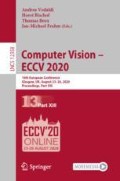Abstract
We investigate a new AI task—Multi-Agent Interactive Question Answering—where several agents explore the scene jointly in interactive environments to answer a question. To cooperate efficiently and answer accurately, agents must be well-organized to have balanced work division and share knowledge about the objects involved. We address this new problem in two stages: Multi-Agent 3D Reconstruction in Interactive Environments and Question Answering. Our proposed framework features multi-layer structural and semantic memories shared by all agents, as well as a question answering model built upon a 3D-CNN network to encode the scene memories. During the reconstruction, agents simultaneously explore and scan the scene with a clear division of work, organized by next viewpoints planning. We evaluate our framework on the IQuADv1 dataset and outperform the IQA baseline in a single-agent scenario. In multi-agent scenarios, our framework shows favorable speedups while remaining high accuracy.
S. Tan and W. Xiang—Equal contribution.
W. Xiang—This work was completed while Weilai Xiang was visiting Tsinghua University, Beijing.
Access this chapter
Tax calculation will be finalised at checkout
Purchases are for personal use only
References
Antol, S., et al.: VQA: Visual question answering. In: Proceedings of the IEEE International Conference on Computer Vision, pp. 2425–2433 (2015)
Chang, A., et al.: Matterport3D: learning from RGB-D data in indoor environments. arXiv preprint arXiv:1709.06158 (2017)
Curless, B., Levoy, M.: A volumetric method for building complex models from range images. In: Proceedings of the 23rd Annual Conference on Computer Graphics and Interactive Techniques, pp. 303–312 (1996)
Das, A., Datta, S., Gkioxari, G., Lee, S., Parikh, D., Batra, D.: Embodied question answering. In: Proceedings of the IEEE Conference on Computer Vision and Pattern Recognition Workshops, pp. 2054–2063 (2018)
Dong, S., et al.: Multi-robot collaborative dense scene reconstruction. ACM Trans. Graph. (TOG) 38(4), 1–16 (2019)
Foerster, J., Assael, I.A., De Freitas, N., Whiteson, S.: Learning to communicate with deep multi-agent reinforcement learning. In: Advances in Neural Information Processing Systems, pp. 2137–2145 (2016)
Gordon, D., Kembhavi, A., Rastegari, M., Redmon, J., Fox, D., Farhadi, A.: IQA: visual question answering in interactive environments. In: Proceedings of the IEEE Conference on Computer Vision and Pattern Recognition, pp. 4089–4098 (2018)
Graham, B., van der Maaten, L.: Submanifold sparse convolutional networks. arXiv preprint arXiv:1706.01307 (2017)
He, K., Gkioxari, G., Dollar, P., Girshick, R.: Mask R-CNN. In: The IEEE International Conference on Computer Vision (ICCV) October 2017
Hou, J., Dai, A., Niessner, M.: 3D-sis: 3D semantic instance segmentation of RGB-D scans. In: The IEEE Conference on Computer Vision and Pattern Recognition (CVPR) June 2019
Huang, P.H., Matzen, K., Kopf, J., Ahuja, N., Huang, J.B.: Deepmvs: learning multi-view stereopsis. In: Proceedings of the IEEE Conference on Computer Vision and Pattern Recognition, pp. 2821–2830 (2018)
Izadi, S., et al.: Kinectfusion: real-time 3D reconstruction and interaction using a moving depth camera. In: Proceedings of the 24th Annual ACM Symposium on User Interface Software and Technology, pp. 559–568 (2011)
Jang, Y., Song, Y., Yu, Y., Kim, Y., Kim, G.: TGIF-QA: toward spatio-temporal reasoning in visual question answering. In: The IEEE Conference on Computer Vision and Pattern Recognition (CVPR) July 2017
Kolve, E., et al.: Ai2-thor: an interactive 3D environment for visual AI. arXiv preprint arXiv:1712.05474 (2017)
Malinowski, M., Rohrbach, M., Fritz, M.: Ask your neurons: a neural-based approach to answering questions about images. In: The IEEE International Conference on Computer Vision (ICCV) December 2015
Mousavi, H.K., Nazari, M., Takáč, M., Motee, N.: Multi-agent image classification via reinforcement learning. arXiv preprint arXiv:1905.04835 (2019)
Savva, M., et al.: Habitat: a platform for embodied AI research. In: Proceedings of the IEEE International Conference on Computer Vision, pp. 9339–9347 (2019)
Stone, P., Veloso, M.: Multiagent systems: a survey from a machine learning perspective. Autonom. Robot. 8(3), 345–383 (2000)
Sukhbaatar, S., Fergus, R., et al.: Learning multiagent communication with backpropagation. In: Advances in Neural Information Processing Systems, pp. 2244–2252 (2016)
Wu, Y., Wu, Y., Gkioxari, G., Tian, Y.: Building generalizable agents with a realistic and rich 3D environment. arXiv preprint arXiv:1801.02209 (2018)
Xia, F., et al.: Gibson Env V2: Embodied simulation environments for interactive navigation (2019)
Yang, W., Wang, X., Farhadi, A., Gupta, A., Mottaghi, R.: Visual semantic navigation using scene priors. arXiv preprint arXiv:1810.06543 (2018)
Zhao, Z., et al.: Video question answering via hierarchical spatio-temporal attention networks. In: IJCAI, pp. 3518–3524 (2017)
Zheng, L., et al.: Active scene understanding via online semantic reconstruction. In: Computer Graphics Forum. vol. 38, pp. 103–114. Wiley Online Library (2019)
Zhu, Y., et al.: Target-driven visual navigation in indoor scenes using deep reinforcement learning. In: 2017 IEEE International Conference on Robotics and Automation (ICRA), pp. 3357–3364. IEEE (2017)
Acknowledgements
This work was supported in part by the National Natural Science Foundation of China under Grants U1613212 and 61703284.
Author information
Authors and Affiliations
Corresponding author
Editor information
Editors and Affiliations
Rights and permissions
Copyright information
© 2020 Springer Nature Switzerland AG
About this paper
Cite this paper
Tan, S., Xiang, W., Liu, H., Guo, D., Sun, F. (2020). Multi-agent Embodied Question Answering in Interactive Environments. In: Vedaldi, A., Bischof, H., Brox, T., Frahm, JM. (eds) Computer Vision – ECCV 2020. ECCV 2020. Lecture Notes in Computer Science(), vol 12358. Springer, Cham. https://doi.org/10.1007/978-3-030-58601-0_39
Download citation
DOI: https://doi.org/10.1007/978-3-030-58601-0_39
Published:
Publisher Name: Springer, Cham
Print ISBN: 978-3-030-58600-3
Online ISBN: 978-3-030-58601-0
eBook Packages: Computer ScienceComputer Science (R0)

